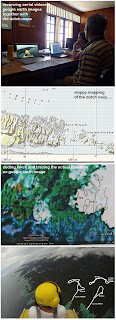- dive booties, preferentially with sturdy anti-slip soles for these slippery slopes and rocks. However, no sole is infallible, so one needs to have handhold security as well. This is why the next piece of equipment is:
- gardening gloves. Ideal for climbing on razor-sharp limestone cliffs, but also to grab onto these vines that may just turn out to be snakes, and to be able to confidently hold on to the next tree that is more often than not covered in aggressive ants. Further protection against the creepy-crawlies is provided by one of the most crucial elements of the lake-explorer-equipment:
- the wetsuit. No mosquito can pierce through this barrier, and the padding ensures that the only consequence of an unfortunate slip is an ugly bruise, and not a deep cut that could rapidly turn into a dreadful infection in tropical environments. Obviously, the wetsuit also provides protection against hypothermia (for these long hours spent in the waters of the lake), against marine stingers (one is never cautious enough when entering unchartered waters) and against sunburn. The wetsuit unfortunately does not yet provide protection against overheating during those strenuous jungle hikes, so one should never forget to bring a water bottle. This will fit into the next piece of equipment:
- the backpack. Bash-able, wet-able and scratch-resistant, the backpack needs to have a capacity of about 40 to 50 litres, to contain the rest of the snorkelling equipment, all the research equipment, and the photographic documentation equipment. Ideally fitted out with specially adapted fin-attachment devices, one must also be able to somehow attach a floating ring to it, to minimise physical exertion during those long hours spent exploring the waters of the lake.
Many optional add-ons are available, e.g. hats and hoods, machetes and dive knifes, ropes and homemade ladders, as are variations on design and colours. For further information do not hesitate to contact Becking Inc., or consult the illustrated 2011 catalogue (excerpt below).







